|
|
Also see Nest ID Matrix (contents) and Egg ID Matrix (color, spots, etc.)
To see other cavity nester bios/photos:
As the pressure of population increasingly regiments us and crowds us closer together, an association with the wild, winged freedom of the birds will fill an ever growing need in our lives.
– Edwin Way Teale, introduction to Songbirds in Your Garden, 1953
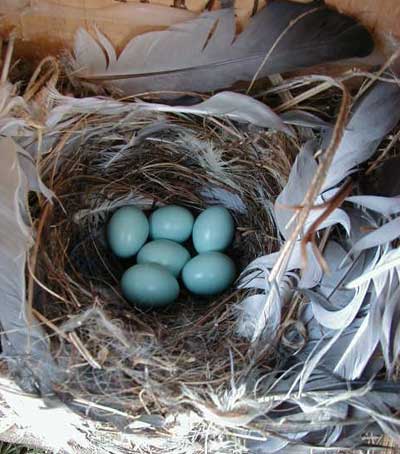
LEFT: Western Bluebird (WEBL) nest photo by Linda Violett. WEBL nests may be more likely than Eastern Bluebird nests to contain trash and feathers, and thus may be confused with House Sparrow nests. The nest on the left has more feathers than usual.
Nest Description: Collection of grasses, weed stems, and, sometimes, hair and feathers. Routinely add ribbons, strips of cellophane, thin bark and leaves to their nest, which may cause some to confuse it with a House Sparrow nest.
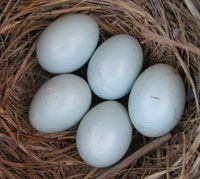
| TOP: WEBL nest in WA, with a few feathers. BELOW: a different nest that appears to have been hastily constructed. Zimmerman photos. | ||
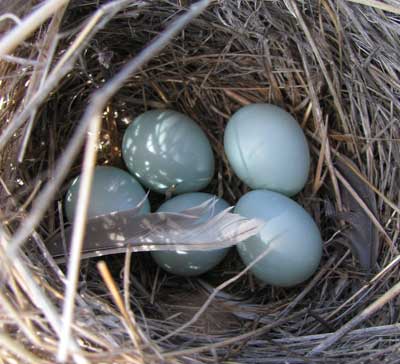 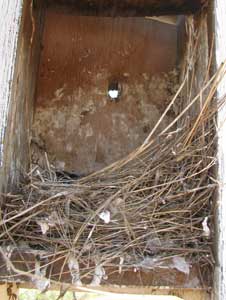 |
||
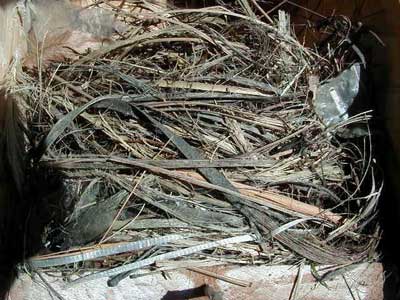 LEFT: This nest contains a lot of coarse straw and bark, along with leaves, cellophane, and a ribbon. Violett photo. LEFT: This nest contains a lot of coarse straw and bark, along with leaves, cellophane, and a ribbon. Violett photo.BELOW: The nest below is shallow, and the cup is lined with cellophane. Linda has also found straw wrappers (common), 8-track tape, shoestring, a large pink costume feather, flowers (Bougainvillea was “in” in 2007), plastic newspaper ties, polyester batting, leaves, cigarette filters, and plastic rings in WEBL nests. Violett photo. |
||
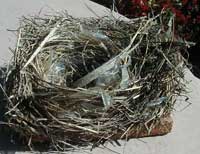 |
||
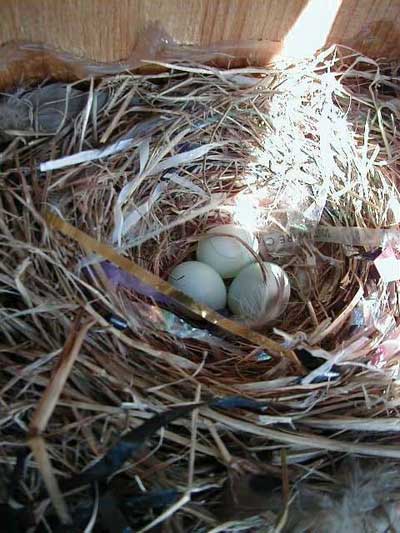 LEFT: This nest contains party ribbons (from a nearby picnic/playground area), a feather, and a strip of paper with writing on it. For more photos of Linda Violett’s Western Bluebirds, click here. LEFT: This nest contains party ribbons (from a nearby picnic/playground area), a feather, and a strip of paper with writing on it. For more photos of Linda Violett’s Western Bluebirds, click here.BELOW#1: Another WEBL nest in Bickleton, WA, without a single accoutrements. Zimmerman photo. |
||
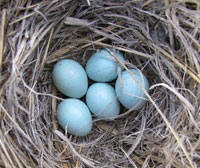 |
||
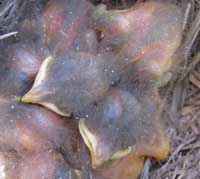 Photo of WEBL nestlings, age unknown. Zimmerman photo Photo of WEBL nestlings, age unknown. Zimmerman photo |
||
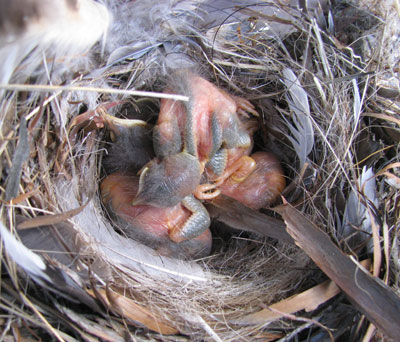 WEBL nestlings, age unknown. Notice the feathers and bark strips in nest. (Photo taken in western WA, by Zimmerman.) WEBL nestlings, age unknown. Notice the feathers and bark strips in nest. (Photo taken in western WA, by Zimmerman.) |
||
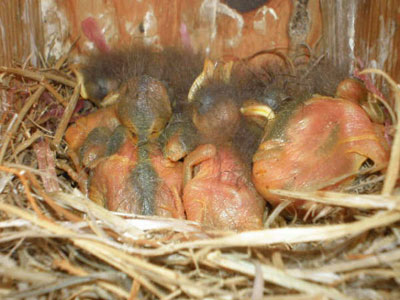 WEBL nestlings. Photo on left by Earl Garrison. Photo below by Beverly Gandall. WEBL nestlings. Photo on left by Earl Garrison. Photo below by Beverly Gandall. |
||
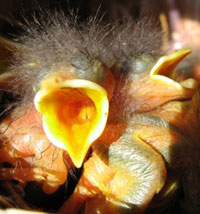 |
||
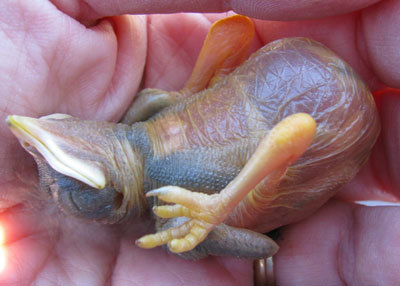 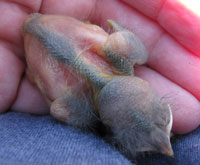 |
||
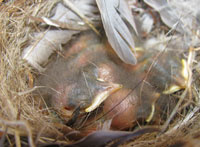 |
||
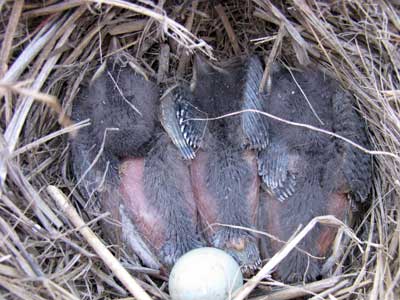 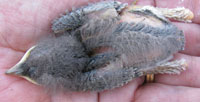 |
||
| WEBL nestlings lined up in a row, with an unhatched egg. Notice feathers have not filled in on back yet. Age unknown. Zimmerman photo. | ||
| WEBL nest in Western WA. Notice how close to the entrance hole the top is. May be a second nest on top of a previous nest. Photos of the young from this nest (age unknown but eyes starting to open) below. Zimmerman photos. | ||
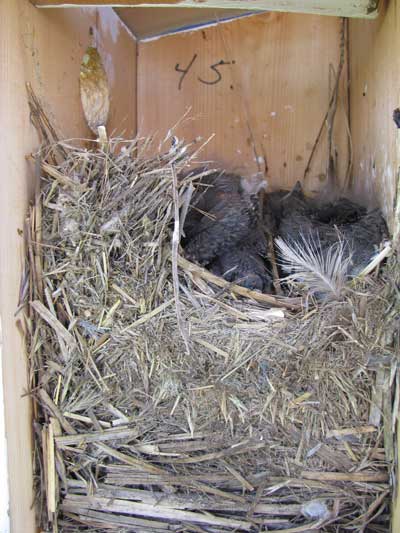 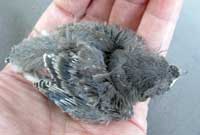 |
||
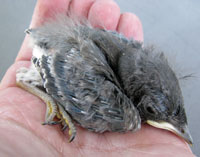 |
||
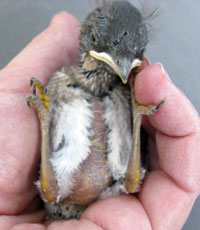 |
||
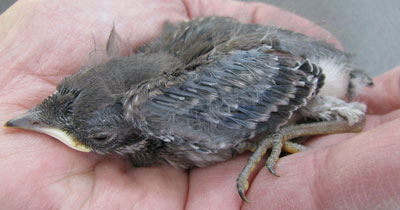 WEBL nestling from nest above. Notice pointy beak, bluish-gray pin feathers coming out, legs with yellowing tinge, white on rump Zimmerman photo. WEBL nestling from nest above. Notice pointy beak, bluish-gray pin feathers coming out, legs with yellowing tinge, white on rump Zimmerman photo. |
||
|
|
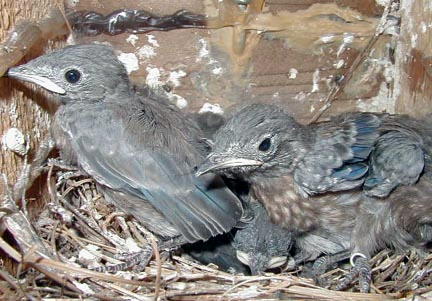 WEBL nestlings. Notice the little one getting squashed in the middle. Photo by Linda Violett. WEBL nestlings. Notice the little one getting squashed in the middle. Photo by Linda Violett. |
|
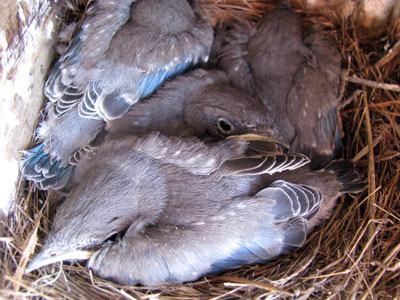 WEBL nestlings from nest in photo below. The nest took up between 1/3 and 1/2 of the box. Zimmerman photos. WEBL nestlings from nest in photo below. The nest took up between 1/3 and 1/2 of the box. Zimmerman photos. |
||
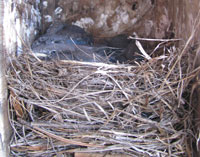 |
||
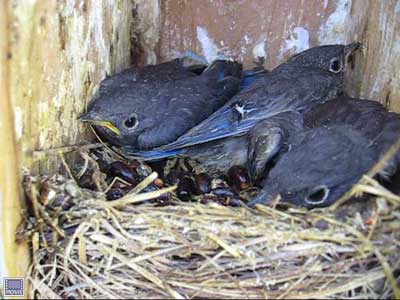 WEBL nestlings, about to fledge. Photo by Beverly Gandall. WEBL nestlings, about to fledge. Photo by Beverly Gandall.
The berry seeds/pits (type unknown) below the birds are found in many boxes in South Orange County. |
||
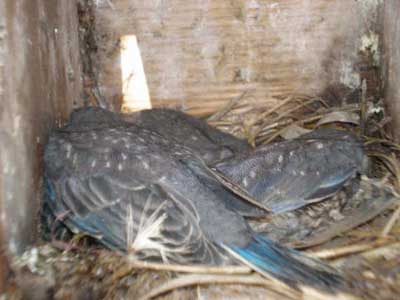 WEBL nestlings at fledging age, at 20 days. Photo by Earl Garrison. Notice the length of the tail on the bird to the left – looks much longer than an EABL fledgling’s tail. WEBL nestlings at fledging age, at 20 days. Photo by Earl Garrison. Notice the length of the tail on the bird to the left – looks much longer than an EABL fledgling’s tail.
These nestlings were orphans that were fostered with another pair of bluebirds. Their story will be in the August 2007 California Bluebird Recovery Program newsletter. |
||
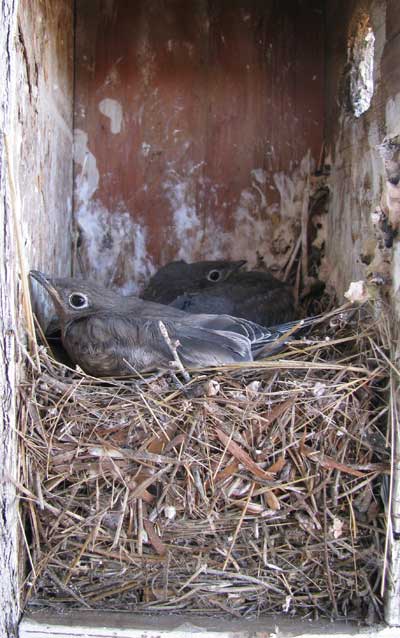 ABOVE: WEBL nest. Notice ‘whitewashing’ on walls, and some fecal sacs stuck on sides. Notice how far down nest is from entrance hole (flattened at this point). Zimmerman photo ABOVE: WEBL nest. Notice ‘whitewashing’ on walls, and some fecal sacs stuck on sides. Notice how far down nest is from entrance hole (flattened at this point). Zimmerman photo
|
||
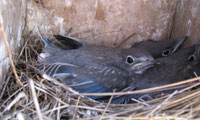 BELOW: WEBLs close to fledging. Fecal sac just came out of bird on left. See larger photo. Zimmerman photo BELOW: WEBLs close to fledging. Fecal sac just came out of bird on left. See larger photo. Zimmerman photo |
||
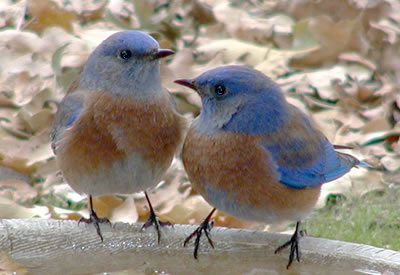 Photo by Wendy Shields in Irvine, CA. She has a mealworm feeder that attracts as many as 10 WEBL’s at a time. Photo by Wendy Shields in Irvine, CA. She has a mealworm feeder that attracts as many as 10 WEBL’s at a time.
|
||
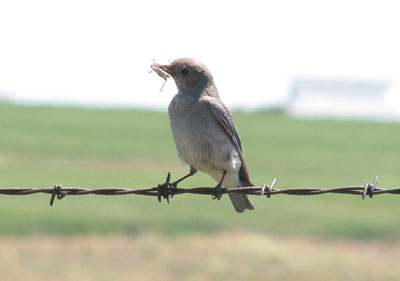 WEBL female in Bickleton, WA. She had a grasshopper in her mouth that she was reluctant to feed to nestlings while I was watching. After a few minutes she ate it herself. Mate below her. Photos by Zimmerman. See more pictures of Bickleton Birds. WEBL female in Bickleton, WA. She had a grasshopper in her mouth that she was reluctant to feed to nestlings while I was watching. After a few minutes she ate it herself. Mate below her. Photos by Zimmerman. See more pictures of Bickleton Birds. |
||
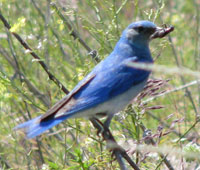 |
As the pressure of population increasingly regiments us and crowds us closer together, an association with the wild, winged freedom of the birds will fill an ever growing need in our lives.
– Edwin Way Teale, introduction to Songbirds in Your Garden, 1953
